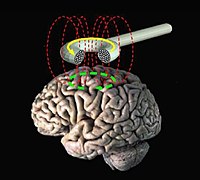
Photo from wikipedia
Transcranial Magnetic Stimulation (TMS) is a neurophysiological technique that is used as a noninvasive diagnostic and therapeutic tool for neurological conditions. This paper addresses the effects of frequency variation on… Click to show full abstract
Transcranial Magnetic Stimulation (TMS) is a neurophysiological technique that is used as a noninvasive diagnostic and therapeutic tool for neurological conditions. This paper addresses the effects of frequency variation on magnetic and induced electric fields for deep brain stimulation scenario, considering the hippocampus region of the brain. A modified magnetic resonance coupling (MMRC) coil is designed and utilised to stimulate a realistic human head model at frequencies from 1 to 30 kHz, with constant and variable excitation current scenarios, while considering safety guidelines inside the brain. Sensitivity analysis is performed to quantify the reliability of field estimates. It is found that, although the maximum value of the induced electric field increases linearly with frequency, the general pattern of that field distribution inside the head demonstrates frequency-independent behaviour. Both depth of stimulation and field focality demonstrate a noticeable change with frequency below 12 kHz, while these attributes are almost saturated above this frequency band when using MMRC coil. It is also noted that, although increasing operating frequency can reduce the excitation current, the safety of the patient is prone to be jeopardized. Hence, to choose the optimum frequency range for the TMS system, several factors including, safety limits, stimulation threshold, desired magnetic flux density, power consumption, and target depth should be considered. This study provides a systematic approach to analyse the efficacy of deep TMS (dTMS) systems by making adequate trade-offs for the frequency selection to stimulate the targeted depth without exceeding safety limits, while using minimum possible power.
Journal Title: IEEE Journal of Electromagnetics, RF and Microwaves in Medicine and Biology
Year Published: 2021
Link to full text (if available)
Share on Social Media: Sign Up to like & get
recommendations!